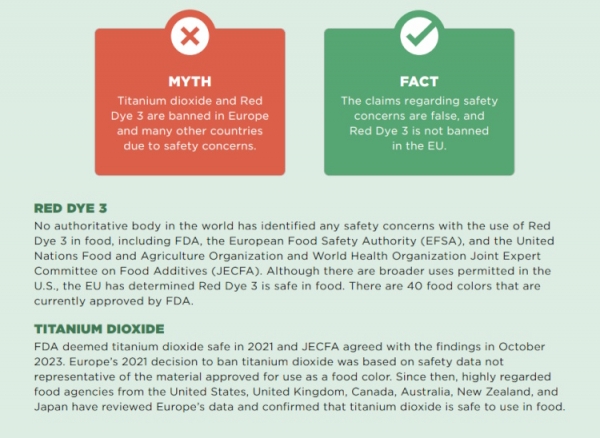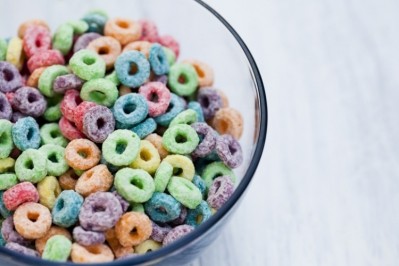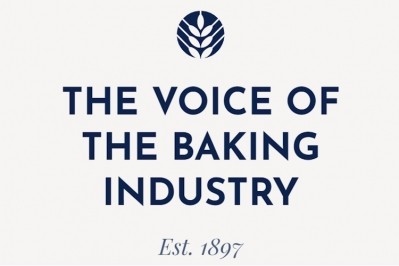With yet another US state joining the growing patchwork to self-regulate food ingredients, we take a deep dive into the state of play

Last week, Pennsylvania State Representative Natalie Mihalek introduced House Bill 2116, while Rep. Melissa Shusterman proposed HB 2117, both aimed to amend food protection legislation to ‘further [provide] for poisonous or deleterious substances and tolerances’.
Like California, Pennsylvania is seeking to deem a raft of food dyes – along with potassium bromate, brominated vegetable oil (BVO) and butylated hydroxyanisole (BHA) – as ‘unsafe’ for the ‘adulteration of food’.
The synthetic colors in question include red dye 3, red dye 40, yellow dye 5, yellow dye 6, blue dye 1 and blue dye 2, typically used by the bakery and confectionery sectors to boost the appeal of cookies, cupcakes and candies, along with snacks, baby food, frozen dairy desserts and medications, including one that, ironically, is used to treat ADHD.
The whole premise behind Assemblymember Jesse Gabriel (D-Encino)’s introduction of Assembly Bill 2316 is research that “suggests that synthetic food dyes are associated with adverse neurobehavioral effects, such as inattentiveness, hyperactivity and restlessness in sensitive children.” All the symptoms of Attention Deficit/Hyperactivity Disorder (ADHD).
Pennsylvania is the latest to join the growing patchwork of US states to self-regulate food ingredients. A move that, yet again, undermines the US Food and Drug Administration (FDA), the federal agency charged to safeguard the American food supply.
At a press conference held on March 19 on the steps of the State Capitol Complex in Harrisburg, and wearing a T-shirt that read ‘Food fight: It’s not you, it’s the food’, Rep. Mihalek noted that, “Since 2000, 99% of our chemicals used in our foods have only been reviewed by food and chemical companies. Once it’s in our food supply, it’s there to stay.”
While the FDA does approve a small fraction of new food chemicals, it doesn’t require premarket approval, notice or its own safety review for the vast majority of chemicals, which instead are determined as GRAS (generally recognized as safe) by the manufacturer themselves.
“It’s time to put public safety over profits,” said Rep. Mihalek, noting the twin House Bills had received enthusiastic bipartisan support.
“I think it speaks it volumes that you have Democrats and Republicans standing together on something like this.”
The conference included speakers from the Environmental Working Group (EWG), Consumer Reports and the American Academy of Pediatrics, along with the silent backing by State Sen. Devlin Robinson.
“Dangerous dyes and additives shown to cause cancer and other serious health and behavioral problems shouldn’t be allowed in our food,” said Brian Ronholm, director of Food Policy for Consumer Reports.
“Unfortunately, the FDA hasn’t taken action to protect the public, despite the well-documented risks these harmful food chemicals pose to our health. By banning these toxic dyes and additives, these bills will protect Pennsylvanians and make our food safer.”
Chain reaction
California kicked off the domino effect five months ago, the first state to place a ban on potassium bromate, propylparaben, red dye 3 and BVO, all frequently found in packaged breads, baked goods and cake decorating gels sold across the US.
California Governor Gavin Newsom signed Assembly Bill 418 – known as the California Food Safety Act, the first law of its kind in the US – on October 7, which prohibits the four from being used as additives in food and beverages manufactured, sold or distributed in the state. The law will not be implemented until 2027, giving producers time to reformulate. Thereafter, penalties are capped at $5,000 for the first violation, but each subsequent violation carries a penalty of up to $10,000.
And yet another
Indiana Rep. John Bartlett has proposed House Bill 1074, which will ban high fructose corn syrup (HFCS) as food ingredient, citing studies it poses a danger to health.
“High-fructose corn syrup has been found to increase risk of chronic conditions like obesity, diabetes and heart disease,” he told the media.
“While HFCS is prevalent in many foods consumed daily – from fruit juice to condiments – many people are unaware of the risks associated with its consumption.
"Recently, Indiana was ranked as the 10th worst state when it comes to facilitating the healthcare needs of its inhabitants. The health department lists heart disease, cancer and respiratory diseases as the top causes of death for Hoosiers [one of Indiana’s Medicaid programs for children and pregnant women]. They attributed a considerable number of cases being related to 34% of Hoosiers being overweight. Since HFCS has been linked to these prevalent conditions in Indiana, I found it appropriate to propose a measure that could reduce both healthcare costs and the risk of deadly diseases.”
In June 2023, New York Senate Bill S6055A was introduced by Senator Brian Kavanagh (D-Lower Manhattan), which also seeks to ban BVO, potassium bromate, propylparaben and red dye 3, as well as titanium dioxide (which was included in the original draft of the California Food Safety Act but then removed).
A second bill, S08615/A9295, was also introduced by Sen. Kavanagh and Assemblymember Dr Anna R Kelles requiring companies to disclose to the state of New York when they add any chemical – even if self-determined as GRAS – to foods and drinks.
In January this year, the Illinois Senate Bill 2637 was introduced to ban BVO, potassium bromate, propylparaben and red dye 3 from foods sold in the state. The Illinois bill also calls for respected local research institutions to study the health risks associated with BHA and BHT, which will then be subjected to additional regulation “if determined they pose a significant health risk.”
Butylated hydroxyanisole (BHA) and butylated hydroxytoluene (BHT) are antioxidants that are commonly used as food preservatives. They’re also used in cosmetics, petroleum products, rubber and plastics.
“If we get it done in Illinois, I think the dominoes are going to fall,” Illinois Secretary of State Alexi Giannoulias – who announced the bill with Sen. Willie Preston and Rep. Anne Stava-Murray – told the media at the time.
“I think people are paying attention. FDA is paying attention. Other states are paying attention. At a certain point, this becomes inevitable.”
His predictions are playing out and bills have now been introduced in Missouri, Washington State, South Dakota and Pennsylvania, all slated to take effect from January 1, 2027. More states are expected to follow suit.
Industry response
The National Confectioners Association (NCA) has made it clear that it’s not a fan of the current landscape.
“Enough is enough. Pennsylvania is the latest in a series of states that is proposing to dismantle our national food safety system in an emotionally driven campaign that lacks scientific backing,” said Chris Grindlesperger, senior VP of Public Affairs and Communications for the NCA.
The association is leading a food industry coalition to clear up misconceptions about food additives and inform policymakers and consumers about the real science and policy process behind this issue.
“The FDA is the only institution in America that can stop this sensationalistic agenda, which is not based on facts and science,” added Grindlesperger.
“It’s time for FDA Commissioner Califf to wake up and get in the game.”
The American Baking Association (ABA) is similarly concerned.
“Food safety is the commercial baking industry's number one concern,” a spokesperson told Bakery&Snacks.
“The ABA supports a science-based approach to food safety regulation and advocates for harmonized standards at the federal level to avoid a patchwork of state laws that could create confusion for food manufacturers and consumers.
“ABA has engaged the FDA on this topic and is awaiting additional follow-up. We point to the FDA’s statement that the agency is reviewing petitions from stakeholders on red dye no. 3, titanium dioxide and potassium bromate.
“ABA is closely monitoring developments in Pennsylvania and other states and continues to coordinate with the broader food sector.”
Sadly, the current state of play has long been in the making. For years, consumer advocates have complained about the agency’s laissez fair attitude in allowing additives to get to market, along with its extremely slow reaction to safety concerns.
It is, however, very aware of the grievances and in June 2023 – before California even introduced its Bill – proposed an overhaul of its Human Foods Program. For decades, the FDA has placed emphasis on its food safety efforts to limit foodborne outbreaks, pushing preservatives, colors and other chemicals added to food under less urgent priorities. It’s obviously struggling to keep up with the requests from advocacy groups, so has proposed a new model for the Office of Regulatory Affairs (ORA), combining the Center for Food Safety and Applied Nutrition (CFSAN), the Office of Food Policy and Response and parts of the ORA under one leader, who will report directly to FDA commissioner Califf.
The plan suggests separate offices for microbial and food chemical safety; housing the vetting of dietary supplements and innovative food ingredients with food chemical safety; and creating another office for risk prioritization and surveillance.
With limited staff and funding at hand, the FDA is proposing to use artificial intelligence (AI) to prioritize which of the thousands of chemicals in food and food packaging it should evaluate for potential safety risks. Banking on extra funding from the president’s office, it plans to develop computer models to help sift through extensive amounts of data and prioritize chemicals as high, medium or low risk.
Guess what’s missing?
On March 11, 2024, the FDA announced its request for $7.2bn from the president’s FY2025 budget, an increase of 7.4% (or $495m) from FY2023.
This has been earmarked to bolster US food supply and root out causes of foodborne illness outbreaks ($15m); support the domestic supply chain through an agency-wide initiative to build resilience and quickly respond to shortages ($12.3m); and reinforce modernization efforts and mission support ($114.8m to the public health employee workforce, $8m to implement the Modernization of Cosmetics Regulation Act, $2 million to support general agency modernization activities, $8.3m to modernize data infrastructure and $1m to expand foreign offices and imported product oversight). $43.6m of the budget is allocated to helping FDA offices and labs function correctly.
“Our request for critical investments will help us address our most urgent priorities, strengthen our public health capacity, advance IT capabilities, and improve agency-wide infrastructure,” said Commissioner Califf.
“The budget will also support the FDA’s ability to prepare for, build resilience to and respond to shortages, support the implementation of expanded cosmetics regulation, and protect and promote a safe, nutritious US food supply.”
However, Scott Faber, senior VP of Government Affairs for the EWG, who attended the Pennsylvania press conference, expressed dismay.
“Just last week, the FDA released its budget request and guess what was missing? Money to review for the safety of these chemicals,” he said.
“The FDA is not doing its job.”
The FDA is on it
Meanwhile, the FDA is already actively reviewing the safety of some of the chemicals currently under state scrutiny.
On November 2, 2023, the agency proposed to revoke the regulation authorizing the use of BVO, citing recent studies that clearly show adverse health effects in animals in levels more closely approximating real-world exposure.
“Therefore, the FDA can no longer conclude that this use of BVO in food is safe,” it announced.
A review of red dye 3 – under what’s known as the Delaney Clause – is currently underway.
Currently approved for use in the European Union, I wonder if the FDA’s ultimate ruling will traverse the Atlantic, especially with a new political cycle coming into force in June …
Is clean label still trending?
The US state bans lean heavily into the topic of clean label, to be covered in depth by Bakery&Snacks in its latest webinar.
We will be tapping some of the best minds the sector has to offer, including Jaclyn Bowen, executive director of the Clean Label Project, Renee Leber, technical services manager for the Institute of Food Technologists, Andy Welch, founder of SRSLY Low Carb and Mike Hughes, head of Research & Insight at FMCG Gurus, to debate the pro’s and con’s of the trend.
The webinar - to be flighted on March 28 - will be available on-demand for three months and is sponsored by Cargill, Corbion, Healthy Food Ingredients, IFF, Lesaffre, Nutek Natural Ingredients and Tate & Lyle.
It’s one not to miss.





















